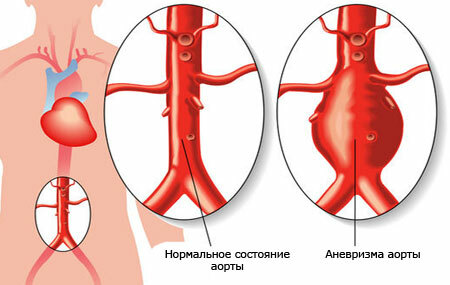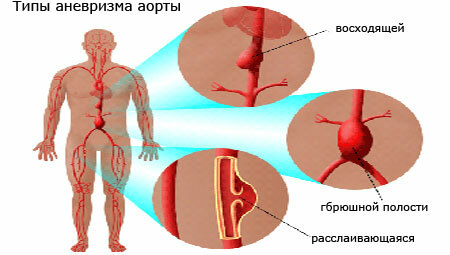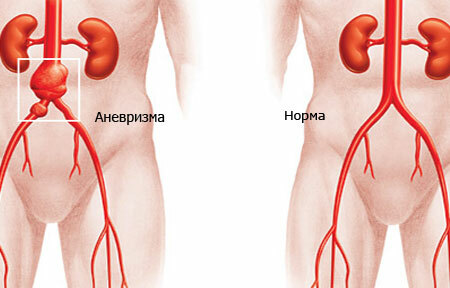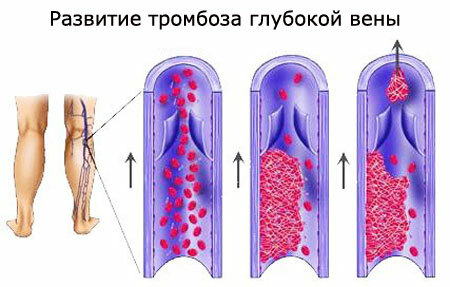Aneurysm of the aorta is a serious pathology, which at the initial stages can be asymptomatic. Previously, this diagnosis and its complications almost always led to the patient's death.
Now the modern diagnostic and treatment equipment allows you to notice the altered portion of the vessel already in the early stages and prevent aortic rupture. Let us consider what this problem is and the approaches to its treatment.
Contents of
- 1 Aortic Aneurysm - What is it?
- 2 Causes of aortic aneurysm
- 3 Symptoms of aortic aneurysm
- 4 Diagnosis of the disease
- 5 Treatment of aneurysm of the aorta
- 5.1 Complications of the aortic aneurysm
- 6 Prognosis and prevention
Aortic aneurysm - What is it?

The aorta is the largest vessel. There are three divisions in it: ascending, descending and arc. In turn, the descending part is divided into the thoracic and abdominal parts.
Aneurysm of the aorta is a protrusion of the wall or enlargement of a particular area, which occurs due to a pathological change in the walls of the vessel.
In the aneurysm zone, the vessel wall is thin and weak and can not withstand blood pressure, which causes the vessel to rupture at the aneurysm site. The risk of developing this formidable complication depends on its size( the more - the higher), the accompanying illnesses of the patient and other factors.
Classification of aneurysm of the aorta
Depending on the location they are divided into an aneurysm of the arch of the aorta, thoracic, abdominal, ascending or combined. In addition, they are divided:
- because of the occurrence: congenital or acquired;
- in appearance and shape: sack, side, spindle-shaped;
- in the clinical course: asymptomatic, complicated( thrombosis, stratification, rupture), uncomplicated, atypical;
- in structure: true( the wall has the same structure as the vessel itself) and false( the wall is formed by scar tissue).
Causes of aortic aneurysm

Types of aneurysm of the aorta
For reasons of occurrence, there are two types of aneurysms. Congenital are caused by abnormalities that occur during the period of intrauterine development.
The cause of development of acquired aneurysms are various diseases:
- Atherosclerosis. This is a chronic pathology, in which pathological plaques are deposited on the walls of the vessels, and the vessels themselves lose their habitual elasticity and elasticity. This is one of the most common causes of this disease.
- Hereditary diseases and genetic abnormalities. Some hereditary diseases predispose to the development of this pathology, for example, Marfan syndrome is a hereditary pathology of connective tissue. In her, the majority of patients have a dissecting aortic aneurysm, which leads to death.
- Some specific infections. For example, syphilis or tuberculosis, can cause weakness and thinning of the aortic wall and the development of an aneurysm of different parts.
- Nonspecific infectious processes( bacterial endocarditis, etc.).
- Autoimmune vascular pathology( Takayasu syndrome).
- Injuries. Thus, an aneurysm of the abdominal aorta is formed, for example, after a stroke in the abdomen.
Important! In the medical literature, cases were recorded where the cause of aneurysm development was fungal vascular lesions against a background of reduced immunity.
In addition to a specific reason, there are a number of contributing factors that can increase the risk of developing this disease:
- sex - this problem is more common in men;
- age - the older the person, the higher the probability of developing this problem;
- smoking and alcohol abuse, as this affects the condition of the vessels;
- excess weight and low physical activity;
- unbalanced power;
- high blood pressure in the absence of control.
Symptoms of an aortic aneurysm

This pathology may not be accompanied by severe symptoms and often makes itself known only at the moment of complication. Sometimes the symptoms of an aortic aneurysm disturb the patient. It depends on its size and localization.
Let us dwell on the main clinical features:
- of the Ascending Aorta. Pain in the chest, lower jaw, sometimes patients are worried about snoring and breathing problems.
- of the Abdominal aorta. Pain in the back, abdomen and chest. The patient may be disturbed by a dry cough, less often there is hoarseness of the voice and problems with breathing begin. - Abdominal aorta. Symptoms of the aortic aneurysm of the abdominal cavity may be manifested by a feeling of discomfort in the abdomen, pain in the epigastric region and back, pulsation.
- The dissecting aortic aneurysm. If it is stratified, then the clinical picture becomes more diverse: the blood pressure drops sharply, the patient is disturbed by severe pain in the chest or abdomen, signs of shock( confusion, convulsions, respiratory failure, etc.) are observed.
Diagnosis of the disease
Since the disease in most cases is asymptomatic, it is usually detected accidentally on a routine examination. Determine the presence of an aneurysm of a department can be done using:
- contrast angiography;
- CT and MRI;
- US of vessels;
- radiography with contrast.
The diagnostic method is chosen by the attending physician, taking into account the expected localization of the problem.
Treatment of aortic aneurysm

Approaches to treatment of aortic aneurysm depend on its size, localization and concomitant diseases of the patient. With her asymptomatic flow and small size, the doctor can recommend only dynamic observation.
Then its parameters are regularly checked and observed for growth and development. If the sizes do not increase, then the treatment is carried out, which implies elimination of risk factors and control of blood pressure.
Emergency surgical treatment is performed when it ruptures. The planned operation for an aneurysm of the abdominal aorta( as well as the other part) consists in replacing part of the altered vessel with a special vascular prosthesis.
Together with traditional operations for aneurysms of the abdominal aorta, endovascular interventions are used. In these cases, an endoprosthesis is inserted through the puncture of the femoral vein using a special catheter into the aneurysm area, which is fixed above and below the aneurysm site.
Such operations are easier to transfer by patients, and the rehabilitation period takes only 3-4 days. They can not be carried out in all situations.
Complications of the aortic aneurysm
The negative consequences of this pathology can be:
- rupture, which is accompanied by massive internal bleeding and usually leads to the patient's death;
- infection of an aneurysm that extends to surrounding soft tissue;
- thrombosis and thromboembolism of other vessels;
- delamination - while the blood penetrates between the layers of the wall of the vessel and gradually exfoliates it in the course of blood flow.
Prognosis and prevention
The prognosis depends on the size of the aneurysm, its location and the presence of complications. So, before in Marfan's syndrome the majority of patients died from aneurysm rupture by the age of 30-35.
Modern medicines and technologies allow to increase life expectancy by about half. Timely treatment allows to avoid many problems with this pathology.
Prevention is the elimination of risk factors. If the sex and age can not be affected in any way, then adjust any excess weight and establish a healthy lifestyle by any person.
Aortic aneurysm is a formidable disease. Timely monitoring of the health status and preventive measures will help to cope with it without life-threatening consequences.



